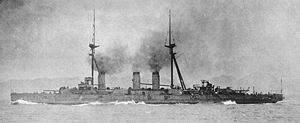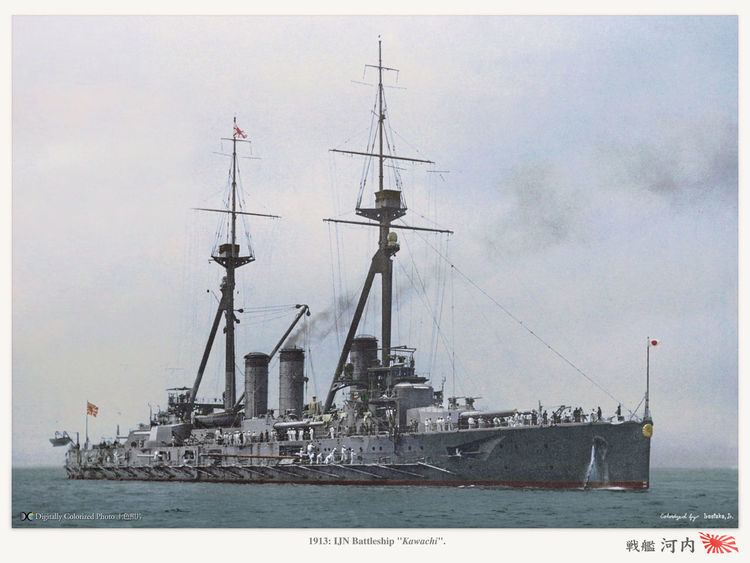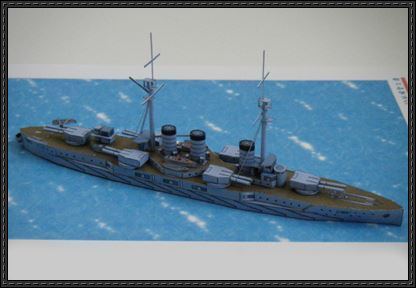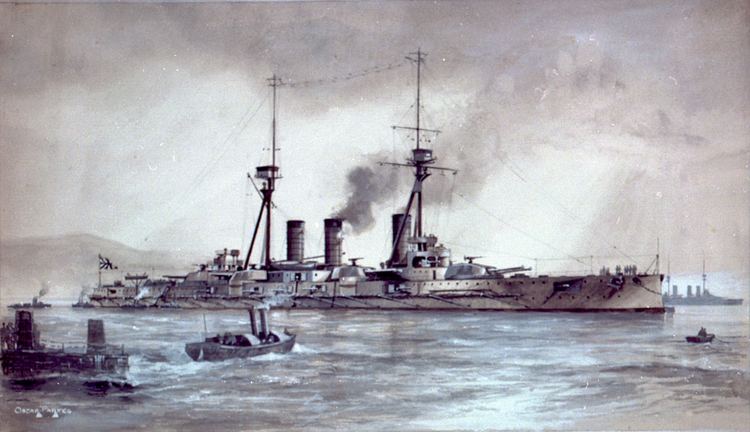Name Kawachi Ordered 22 June 1907 Commissioned 31 March 1912 Construction started 1 April 1909 Length 160 m | Laid down 1 April 1909 Struck 21 September 1918 Launched 15 October 1910 | |
 | ||
Kawachi (河内) was the lead ship of the two-ship Kawachi-class dreadnought battleships built for the Imperial Japanese Navy (IJN) in the first decade of the 20th century. Following the Japanese ship-naming conventions, Kawachi was named after Kawachi Province, now a part of Osaka prefecture. During World War I she bombarded German fortifications at Tsingtao during the Battle of Tsingtao in 1914, but saw no other combat. She sank in 1918 after an explosion in her ammunition magazine with the loss of over 600 officers and crewmen.
Contents

Background

The Kawachi class was ordered on 22 June 1907 under the 1907 Warship Supplement Program after the Russo-Japanese War as Japan's first dreadnoughts, although their construction was delayed by a severe depression. Their design was based on the Aki with a uniform 12-inch (305 mm) main-gun armament, although cost considerations prevented all the guns from having the same barrel length.
Design and description

The ship had an overall length of 526 feet (160.3 m), a beam of 84 feet 3 inches (25.7 m), and a normal draft of 27 feet (8.2 m). She displaced 20,823 long tons (21,157 t) at normal load. Her crew ranged from 999 to 1100 officers and enlisted men. Kawachi was fitted with a pair of license-built Curtis steam turbine sets, each set driving one propeller, using steam from 16 Miyabara water-tube boilers. The turbines were rated at a total of 25,000 shaft horsepower (19,000 kW) for a design speed of 21 knots (39 km/h; 24 mph). She carried enough coal and fuel oil to give her a range of 2,700 nautical miles (5,000 km; 3,100 mi) at a speed of 18 knots (33 km/h; 21 mph).

Kawachi's main armament consisted of four 50-caliber 12-inch 41st Year Type guns in two twin-gun turrets, one each fore and aft of the superstructure, and eight 45-caliber 12-inch 41st Year Type guns mounted in four twin-gun turrets, two on each side of the superstructure. Kawachi's secondary armament was ten 45-caliber 6-inch 41st Year Type guns, mounted in casemates in the sides of the hull, and eight 40-caliber quick-firing (QF) 4.7-inch 41st Year Type guns. The ship was also equipped with a dozen 40-caliber 3-inch 4th Year Type guns and four others were used as saluting guns. In addition, the battleship was fitted with five submerged 18-inch (457 mm) torpedo tubes, two on each broadside and one in the stern.
The waterline main belt of the ship had a maximum thickness of 12 inches amidships. It tapered to a thickness of 5 inches (127 mm) at the ends of the ship. A 6-inch (152 mm) strake of armor protected the casemates. The barbettes for the main guns were 9–11 inches (229–279 mm) thick. The armor of Kawachi's main gun turrets had a maximum thickness of 11 inches. The deck armor was 1.1 inches (29 mm) thick and the conning tower was protected by 6 to 10 inches of armor.
Construction and career
Kawachi was laid down at Yokosuka Naval Arsenal on 1 April 1909. She was launched on 15 October 1910 in a ceremony attended by Emperor Meiji and completed on 31 March 1912 at a cost of ¥11,130,000. On 3 October 1912, the ship was present when the battleship Mikasa had a fire that was started by a sailor in the forward magazine. It was flooded before the fire could get out of control and Kawachi sent over fire-fighting teams to assist Mikasa's crew in case they were needed. When World War I began in August 1914, Kawachi was at Yokosuka.
Together with her sister ship, Settsu, she bombarded German fortifications in October–November 1914 during the final stage of the Battle of Tsingtao. The ship was present in Yokosuka on 8 January 1915 when the victorious Second Squadron returned to Japan after the Battle of Tsingtao. She was assigned to the First Squadron from 1915–1917 and refitted that latter year.
Kawachi rejoined the First Squadron after her refit commanded by Captain Yoshimoto Masaki and entered Tokuyama Bay on the evening of 11 July 1918. The following morning torpedo target practice was cancelled due to rough seas and the battleship remained at anchor for the rest of the day. That afternoon a loud explosion was heard at 15:51 in the vicinity of the starboard forward main-gun turret and large quantities of smoke erupted from the turret and between the first and second funnels. Two minutes later, she began to list to starboard and capsized at 15:55, only four minutes after the explosion. Over a thousand men were aboard Kawachi at the time of the explosion and over 600 were killed, with 433 survivors.
The Imperial Japanese Navy convened a commission to investigate the explosion the day after the incident with Vice Admiral Murakami Kakuichi as chairman. The commission first suspected arson, but no plausible suspect could be found and it reported that the cordite in her magazine might have spontaneously ignited due to decomposition. Kawachi's magazines had been inspected in January–February 1918, however, and no problems were discovered, which made that possibility less likely. The commission made recommendations on tighter control of production and handling of cordite that were successfully adopted by the navy. The Japanese Navy considered salvaging Kawachi, but ultimately decided that it would be too expensive and would delay the construction of one battlecruiser by over a year. Stricken from the navy list on 21 September 1918, the wreck was later partially dismantled although most of the hull was abandoned in place to serve as an artificial reef.
